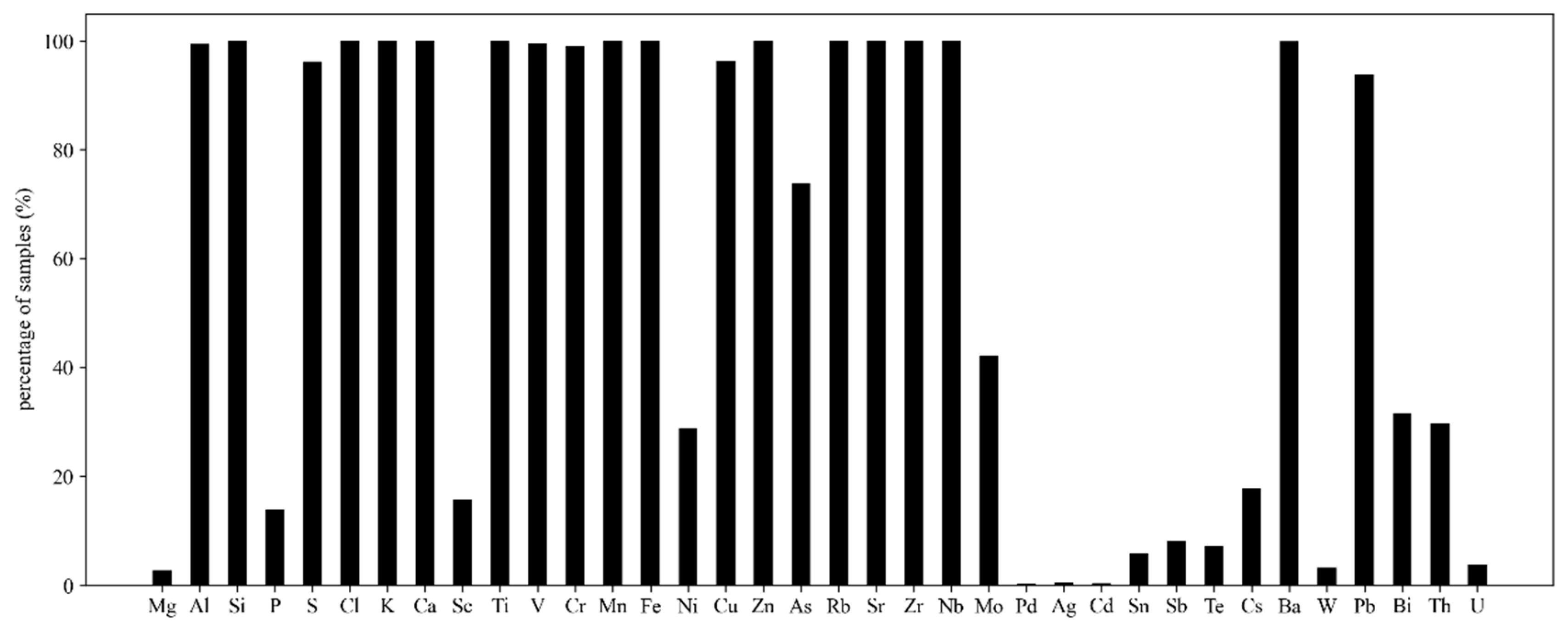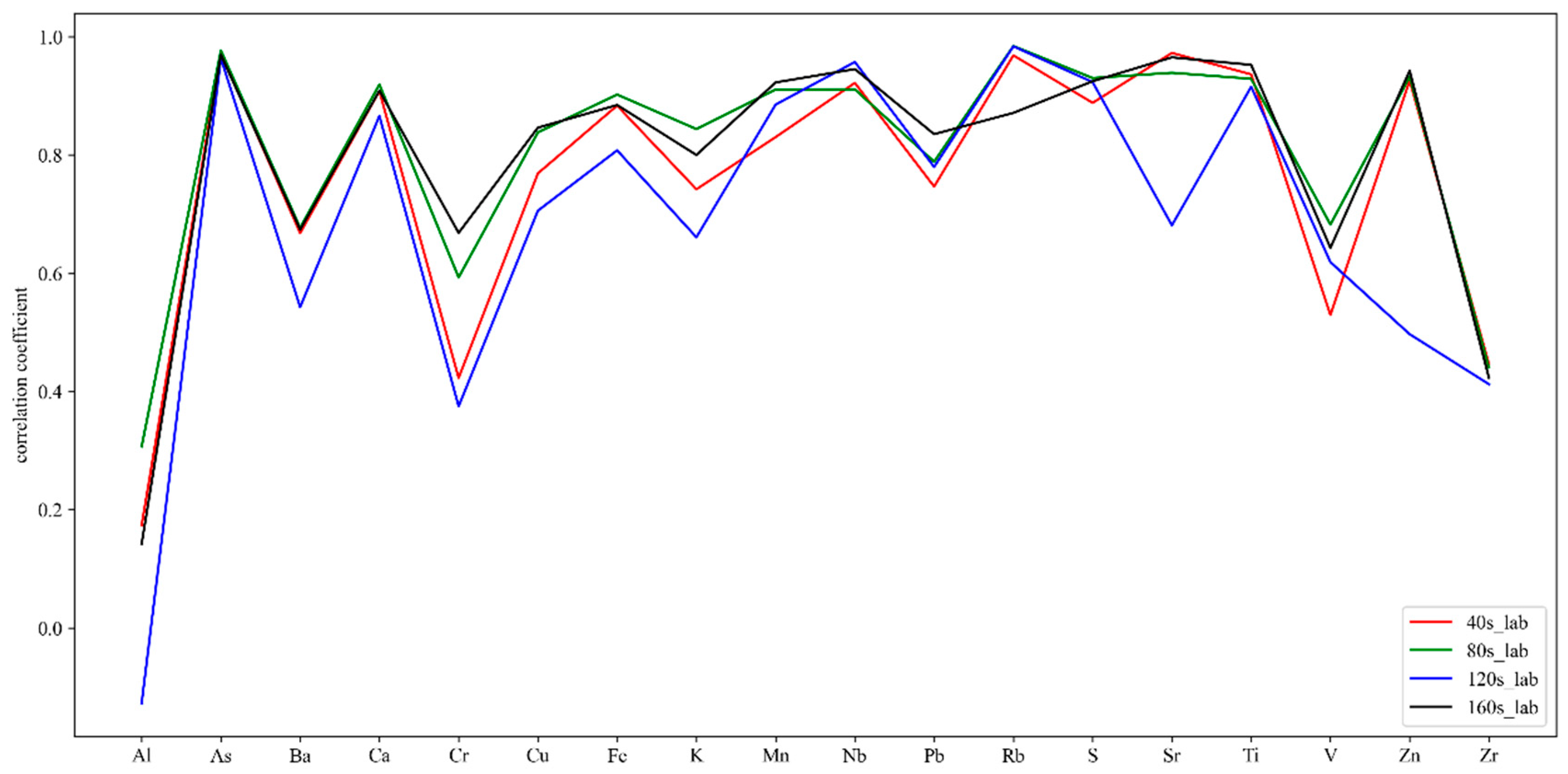The Application of Portable X-ray Fluorescence (pXRF) for Elemental Analysis of Sediment Samples in the Laboratory and Its Influencing Factors
Abstract
:1. Introduction
2. Materials and Methods
2.1. Sample Collection and Processing
2.2. Analyzing Method by pXRF
2.3. Laboratory Analysis Method
3. Results
3.1. The Elemental Detection Capability of pXRF
3.2. Correlation Analysis between pXRF and Laboratory Analysis Results
3.3. Influence of Sample Size on Element Detection Results
3.4. Effect of Sample Grinding on pXRF Analysis
3.5. Influence of Count Time on the Analysis Results
3.6. Influence of Element Content on Error of pXRF Analysis
4. Discussion
5. Conclusions
Author Contributions
Funding
Data Availability Statement
Acknowledgments
Conflicts of Interest
References
- Cheng, Q. Mapping singularities with stream sediment geochemical data for prediction of undiscovered mineral deposits in Gejiu, Yunnan Province, China. Ore Geol. Rev. 2007, 32, 314–324. [Google Scholar] [CrossRef]
- Yousefi, M.; Kamkar-Rouhani, A.; Carranza, E.J.M. Geochemical mineralization probability index (GMPI): A new approach to generate enhanced stream sediment geochemical evidential map for increasing probability of success in mineral potential mapping. J. Geochem. Explor. 2012, 115, 24–35. [Google Scholar] [CrossRef]
- Krippner, A.; Meinhold, G.; Morton, A.C.; Schoenig, J.; von Eynatten, H. Heavy minerals and garnet geochemistry of stream sediments and bedrocks from the Almklovdalen area, Western Gneiss Region, SW Norway: Implications for provenance analysis. Sediment. Geol. 2016, 336, 96–105. [Google Scholar] [CrossRef]
- Xiang, J.; Xia, P.; Xiao, K.; Carranza, E.J.M.; Chen, J. Single-element Anomaly Mapping from Stream Sediment Geochemical Landscapes Aided by Digital Terrain Analysis. Acta Geol. Sin.-Engl. Ed. 2023, 97, 149–162. [Google Scholar] [CrossRef]
- Behera, S.; Panigrahi, M.K. Mineral prospectivity modelling using singularity mapping and multifractal analysis of stream sediment geochemical data from the auriferous Hutti-Maski schist belt, S. India. Ore Geol. Rev. 2021, 131, 104029. [Google Scholar] [CrossRef]
- Ghezelbash, R.; Maghsoudi, A.; Carranza, E.J.M. Mapping of single- and multi-element geochemical indicators based on catchment basin analysis: Application of fractal method and unsupervised clustering models. J. Geochem. Explor. 2019, 199, 90–104. [Google Scholar] [CrossRef]
- Xie, X.; Wang, X.; Zhang, Q.; Zhou, G.; Cheng, H.; Liu, D.; Cheng, Z.; Xu, S. Multi-scale geochemical mapping in China. Geochem. Explor. Environ. Anal. 2008, 8, 333–341. [Google Scholar] [CrossRef]
- Xie, X. Global geochemical mapping-Historical development and suggestions of future work. Geol. China 2008, 35, 357–374, (In Chinese with English Abstract). [Google Scholar]
- Ranasinghe, P.N.; Fernando, G.W.A.R.; Dissanayake, C.B.; Rupasinghe, M.S.; Witter, D.L. Statistical evaluation of stream sediment geochemistry in interpreting the river catchment of high-grade metamorphic terrains. J. Geochem. Explor. 2009, 103, 97–114. [Google Scholar] [CrossRef]
- Xie, X.; Mu, X.; Ren, T. Geochemical mapping in China. J. Geochem. Explor. 1997, 60, 99–113. [Google Scholar]
- Zhang, B. Advances in the research of geochemical exploration methods in special landscape areas of western China. Geophys. Geochem. Explor. 2008, 32, 473–476, (In Chinese with English Abstract). [Google Scholar]
- Xi, X.; Li, M. Summary of modern exploration geochemistry scientific system: Commentary on exploration achievements obtained in the period of ‘12th Five-Year Plan’. Geophys. Geochem. Explor. 2017, 41, 779–793, (In Chinese with English Abstract). [Google Scholar]
- Sarala, P. Comparison of different portable XRF methods for determining till geochemistry. Geochem. Explor. Environ. Anal. 2016, 16, 181–192. [Google Scholar] [CrossRef]
- Sterk, R.; Gazley, M.F.; Wood, M.P.; Collins, K.S.; Collis, G. Maximising the value of Portable XRF data in exploration: An example from Marirongoe, Mozambique. Geochem. Explor. Environ. Anal. 2018, 18, 142–154. [Google Scholar] [CrossRef]
- Radu, T.; Diamond, D. Comparison of soil pollution concentrations determined using AAS and portable XRF techniques. J. Hazard. Mater. 2009, 171, 1168–1171. [Google Scholar] [CrossRef]
- Havukainen, J.; Hiltunen, J.; Puro, L.; Horttanainen, M. Applicability of a field portable X-ray fluorescence for analyzing elemental concentration of waste samples. Waste Manag. 2019, 83, 6–13. [Google Scholar] [CrossRef]
- Vonopartis, L.C.; Booysen, R.; Nex, P.A.M.; Kinnaird, J.A.; Robb, L.J. Combined satellite and portable XRF exploration mapping of the Zaaiplaats tin field, South Africa. S. Afr. J. Geol. 2022, 125, 45–60. [Google Scholar] [CrossRef]
- Zhou, S.; Wang, J.; Wang, W.; Liao, S. Evaluation of Portable X-ray Fluorescence Analysis and Its Applicability as a Tool in Geochemical Exploration. Minerals 2023, 13, 166. [Google Scholar] [CrossRef]
- Walser, S.L.L.; Sirkovich, E.C.C.; Richardson, J.B.B.; McStay, A.E.E.; Perdrial, N. Moisture, organic matter, and large particle correction for accurate Pb portable X-ray fluorescence assessment in urban soils. X-Ray Spectrom. 2022, 52, 72–82. [Google Scholar] [CrossRef]
- Nawar, S.; Richard, F.; Kassim, A.M.; Tekin, Y.; Mouazen, A.M. Fusion of Gamma-rays and portable X-ray fluorescence spectral data to measure extractable potassium in soils. Soil Tillage Res. 2022, 223, 105472. [Google Scholar] [CrossRef]
- Stockmann, U.; Cattle, S.R.; Minasny, B.; McBratney, A.B. Utilizing portable X-ray fluorescence spectrometry for in-field investigation of pedogenesis. Catena 2016, 139, 220–231. [Google Scholar] [CrossRef]
- McGladdery, C.; McGladdery, C.; Weindorf, D.C.; Chakraborty, S.; Li, B.; Paulette, L.; Podar, D.; Pearson, D.; Kusi, N.Y.O.; Duda, B. Elemental assessment of vegetation via portable X-ray fluorescence (PXRF) spectrometry. J. Environ. Manag. 2018, 210, 210–225. [Google Scholar] [CrossRef]
- Zhou, S.; Weindorf, D.C.; Cheng, Q.; Ynag, B.; Yuan, Z.; Chakraborty, S. Elemental assessment of vegetation via portable XRF: Sample preparation and methodological considerations. Spectroc. Acta Pt. B-Atom. Spectr. 2020, 174, 105999. [Google Scholar] [CrossRef]
- Zhang, X.; Wells, E.M.; Specht, A.J.; Weisskopf, M.G.; Weuve, J.; Nie, L.H. In vivo quantification of strontium in bone among adults using portable x-ray fluorescence. J. Trace Elem. Med. Biol. 2022, 74, 127077. [Google Scholar] [CrossRef]
- Charalambous, A.; Papasavvas, G.; Kassianidou, V. Enkomi (Cyprus): Using pXRF spectroscopy to identify LBA copper alloys. J. Archaeol. Sci. Rep. 2021, 35, 2726. [Google Scholar] [CrossRef]
- Merkaj, E.; Civici, N. Application of a Portable XRF Spectrometer for In-Situand Nondestructive Investigation of Pigments in Two 15th Century Icons. Open J. Appl. Sci. 2020, 10, 305–317. [Google Scholar]
- Zhang, L.; Sun, Y.; Xu, H.; Hou, F. p-XRF for the Detection of the Elemental Content in the Glaze Layer of Chinese Glazed Tiles. Int. J. Archit. Herit. 2022, 1–14. [Google Scholar] [CrossRef]
- Zhou, S.; Zhou, K.; Cui, Y.; Wang, J.; Ding, J. Exploratory data analysis and singularity mapping in geochemical anomaly identification in Karamay, Xinjiang, China. J. Geochem. Explor. 2015, 154, 171–179. [Google Scholar]
- Zhou, B.; Zhang, Z.; Shi, Z.; Song, H.; Yu, L. Geochemistry, Geochronology, and Prospecting Potential of the Dahongliutan Pluton, Western Kunlun Orogen. Appl. Sci. 2022, 12, 11591. [Google Scholar] [CrossRef]
- Babek, O.; Grygar, T.M.; Famera, M.; Hron, K.; Novakova, T.; Sedlacek, J. Geochemical background in polluted river sediments: How to separate the effects of sediment provenance and grain size with statistical rigour? Catena 2015, 135, 240–253. [Google Scholar] [CrossRef]
- Darwish, M.A.G.; Poellmann, H. Geochemical exploration for gold in the Nile Valley Block (A) area, Wadi Allaqi, South Egypt. Geochemistry 2010, 70, 353–362. [Google Scholar] [CrossRef]




| Region | Center Location | Deposit Type in the Area | Sample Number | |
|---|---|---|---|---|
| Longitude | Latitude | |||
| Hatu | 84.38 | 45.91 | gold deposit | 456 |
| Moyu | 79.29 | 36.89 | no known deposit | 211 |
| Hongliutan | 79.28 | 35.84 | lithium deposit | 18 |
| Element | Mg | Al | Si | P | S | Cl | K | Ca | Sc |
| corr | 0.58 | 0.27 | * | −0.03 | 0.74 | * | 0.54 | 0.88 | 0.07 |
| Element | Ti | V | Cr | Mn | Fe | Ni | Cu | Zn | As |
| corr | 0.7 | 0.64 | 0.54 | 0.85 | 0.85 | 0.02 | 0.7 | 0.92 | 0.98 |
| Element | Rb | Sr | Zr | Nb | Mo | Pd | Ag | Cd | Sn |
| corr | 0.92 | 0.96 | 0.75 | 0.68 | 0.23 | * | * | # | −0.15 |
| Element | Sb | Te | Cs | Ba | W | Pb | Bi | Th | U |
| corr | 0.28 | −0.22 | −0.2 | 0.64 | −0.12 | 0.58 | −0.12 | 0.89 | −0.27 |
| Element | par1 | par2 | par3 | par4 | Element | par1 | par2 | par3 | par4 |
|---|---|---|---|---|---|---|---|---|---|
| Al | 0.71 | −0.06 | −0.03 | 0.24 | Nb | 0.74 | 0.8 | 0.69 | 0.44 |
| As | 0.84 | 0.97 | 0.97 | 0.99 | Pb | 0.45 | 0.73 | 0.72 | 0.64 |
| Ba | 0.92 | 0.88 | 0.21 | 0.17 | Rb | 0.78 | 0.94 | 0.96 | 0.96 |
| Ca | 0.44 | 0.85 | 0.93 | 0.98 | S | 0.64 | 0.41 | 0.81 | 0.96 |
| Cr | 0.59 | 0.64 | 0.49 | 0.6 | Sr | 0.92 | 0.99 | 0.98 | 0.98 |
| Cu | 0.74 | 0.83 | 0.5 | 0.91 | Ti | 0.41 | 0.78 | 0.58 | 0.92 |
| Fe | 0.82 | 0.87 | 0.85 | 0.97 | V | 0.65 | 0.55 | 0.48 | 0.82 |
| K | 0.5 | 0.2 | 0.76 | 0.84 | Zn | 0.62 | 0.92 | 0.96 | 0.99 |
| Mn | 0.77 | 0.86 | 0.96 | 0.91 | Zr | 0.19 | 0.37 | 0.48 | 0.2 |
| Element | Uncrushed_Lab | Crushed_Lab | Element | Uncrushed_Lab | Crushed_Lab |
|---|---|---|---|---|---|
| Al | 0.27 | 0.5 | Nb | 0.68 | 0.81 |
| As | 0.98 | 1 | Pb | 0.58 | 0.86 |
| Ba | 0.63 | 0.56 | Rb | 0.92 | 0.98 |
| Ca | 0.88 | 0.95 | S | 0.75 | 0.94 |
| Cr | 0.53 | 0.54 | Sr | 0.95 | 0.97 |
| Cu | 0.7 | 0.79 | Ti | 0.7 | 0.91 |
| Fe | 0.85 | 0.9 | V | 0.64 | 0.67 |
| K | 0.55 | 0.85 | Zn | 0.92 | 0.96 |
| Mn | 0.85 | 0.98 | Zr | 0.75 | 0.76 |
Disclaimer/Publisher’s Note: The statements, opinions and data contained in all publications are solely those of the individual author(s) and contributor(s) and not of MDPI and/or the editor(s). MDPI and/or the editor(s) disclaim responsibility for any injury to people or property resulting from any ideas, methods, instructions or products referred to in the content. |
© 2023 by the authors. Licensee MDPI, Basel, Switzerland. This article is an open access article distributed under the terms and conditions of the Creative Commons Attribution (CC BY) license (https://creativecommons.org/licenses/by/4.0/).
Share and Cite
Zhou, S.; Wang, J.; Bai, Y.; Wang, W.; Wang, S. The Application of Portable X-ray Fluorescence (pXRF) for Elemental Analysis of Sediment Samples in the Laboratory and Its Influencing Factors. Minerals 2023, 13, 989. https://doi.org/10.3390/min13080989
Zhou S, Wang J, Bai Y, Wang W, Wang S. The Application of Portable X-ray Fluorescence (pXRF) for Elemental Analysis of Sediment Samples in the Laboratory and Its Influencing Factors. Minerals. 2023; 13(8):989. https://doi.org/10.3390/min13080989
Chicago/Turabian StyleZhou, Shuguang, Jinlin Wang, Yong Bai, Wei Wang, and Shanshan Wang. 2023. "The Application of Portable X-ray Fluorescence (pXRF) for Elemental Analysis of Sediment Samples in the Laboratory and Its Influencing Factors" Minerals 13, no. 8: 989. https://doi.org/10.3390/min13080989
APA StyleZhou, S., Wang, J., Bai, Y., Wang, W., & Wang, S. (2023). The Application of Portable X-ray Fluorescence (pXRF) for Elemental Analysis of Sediment Samples in the Laboratory and Its Influencing Factors. Minerals, 13(8), 989. https://doi.org/10.3390/min13080989








